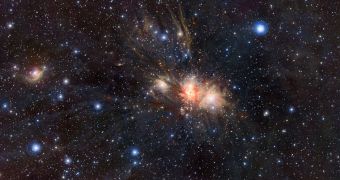Astronomers operating the VISTA survey telescope have recently snapped an incredibly-beautiful image of the star-forming region Monoceros R2, which is located within the constellation of Monoceros (the Unicorn).
The new photograph was snapped in infrared wavelengths, which ensured that the maximum amount of detail was extracted following the research. Areas such as Monoceros R2 are generally shrouded in thick layers of dust.
Infrared wavelengths can peer deep into the heart of nebulae, right to young blue stars that are forming at their very cores. Dust prevents visible wavelengths from passing through.
The VISTA observatory that was used to snap the new view of the Unicorn Nebula is based at the European Southern Observatory's (ESO) Paranal Observatory, in northern Chile.
The instrument, called the Visible and Infrared Survey Telescope for Astronomy, was capable of seeing the nebula hidden at the very core of the Monoceros constellation, in a thick molecular cloud.
Areas such as this one are especially suited for the formation of new stars, experts explain, because they contain vast amounts of space dust and hydrogen gas, organized in massive clouds.
As they grow, these clouds eventually reach a threshold beyond which they can no longer support their own weight, and fall in on themselves. Huge friction forces develop in the process.
If sufficient amounts of matter are in the cloud when it begins collapsing, than the friction will ignite the mix, and thermonuclear reactions will appear. This marks the birth of a new star.
Protected inside the remaining dust and gas, the protostar will cannibalize everything around it until it finally develops into a young blue star.
Some stellar nurseries are very active, and are capable of producing tens to hundreds of new stars each year. Monoceros R2 is an active nebula too.
“When I first saw this image I just said ‘Wow!’ I was amazed to see all the dust streamers so clearly around the Monoceros R2 cluster, as well as the jets from highly embedded young stellar objects,” explains astronomer Jim Emerson.
“There is such a great wealth of exciting detail revealed in these VISTA images,” adds the expert, who is based at the Queen Mary, University of London. He is also the leader of the VISTA consortium.
“Monoceros R2 has a dense core, no more than two light-years in extent, which is packed with very massive young stars, as well as a cluster of bright infrared sources, which are typically new-born massive stars still surrounded by dusty discs,” an ESO press release says.
“This region lies at the centre of the image, where a much higher concentration of stars is visible on close inspection and where the prominent reddish features probably indicate emission from molecular hydrogen,” it concludes.

 14 DAY TRIAL //
14 DAY TRIAL //